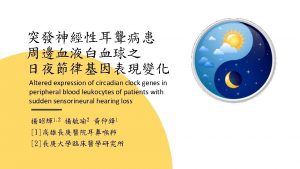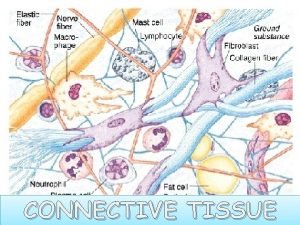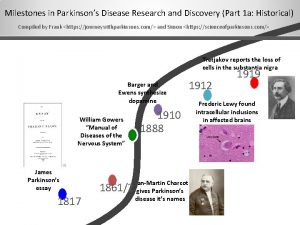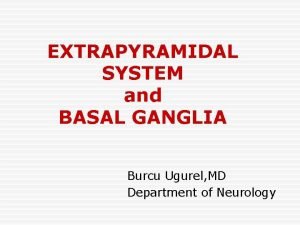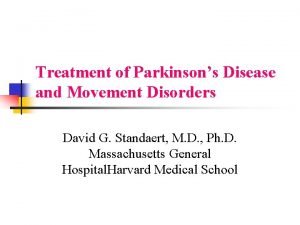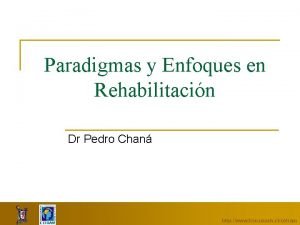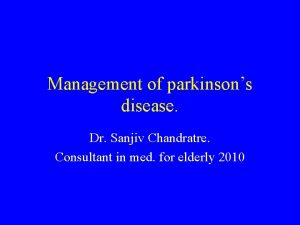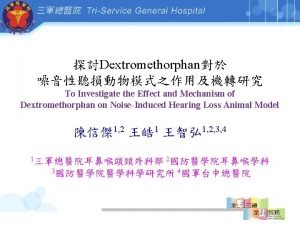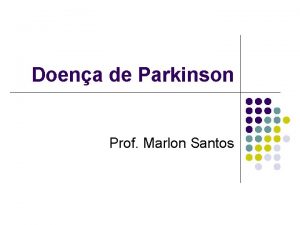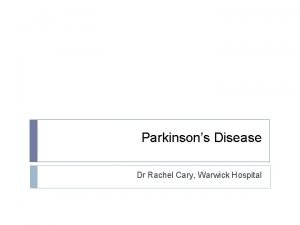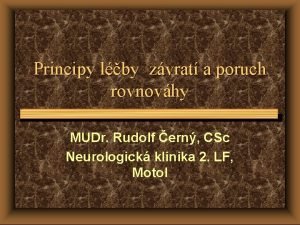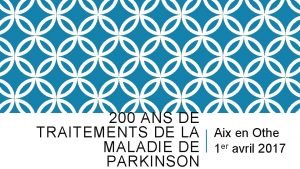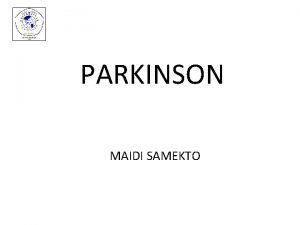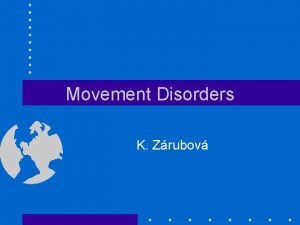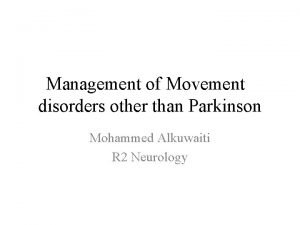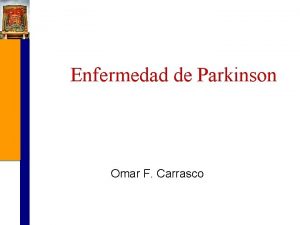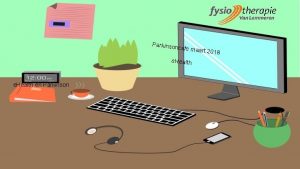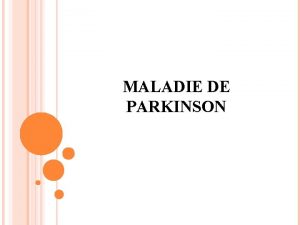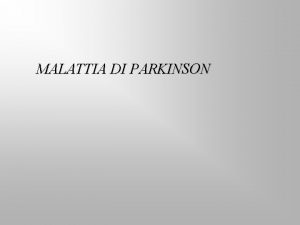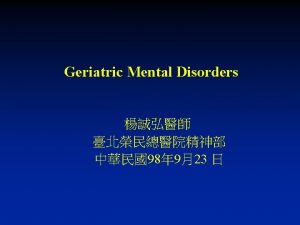Movement disorders Parkinson disease is a disease with






















- Slides: 22

Movement disorders

Parkinson disease: is a disease with certain clinical features (idiopathic). Parkinson Syndrome (Parkinson plus): a term includes a list of DDX contains many other diseases that have parkinsonian picture. • Multiple systems atrophy (MSA) • Progressive supranuclear palsy

• Parkinson disease The disease was discovered by Dr. James Parkinson


Clinical features 1 - Tremors occurring in the limbs, jaws and face 2 -Bradykinesia (slow movement) 3 -Impaired balance and coordination 4 -Stiffness of the limbs and trunk The presentation is almost always unilateral, a resting tremor in an upper limb being a common presenting feature.

Epidemiology q. Average of onset 62. 5. q. Men and women affected equally. q. Genetic Link. q. Caffeine and smoking shows some protective effects. q. Trauma (boxing)

General physical abnormality • Expressionless face • Greasy skin • Soft, rapid, indistinct speech • Flexed posture • Impaired postural reflexes

Tremor § Resting 4 -6 Hz § Usually first in fingers/thumb Coarse, complex movements, flexion/extension fingers. Abduction/adduction of thumb Supination/pronation of forearm pill rolling § Diminished on action

Rigidity • Cogwheel type, mostly upper limbs. • Plastic (lead pipe) type, mostly legs. Bradykinesia • Slowness in initiating or repeating movements • Impaired fine movements, especially of fingers

gait abnormality • Slow to start walking. • Rapid, small steps, tendency to run (festination). • Reduced arm swing. • Impaired balance on turning.

Diagnosis • There is no specific diagnostic test , it is mainly clinical diagnosis • Bradykinesia must be present with at least two of the following: Ø limb muscle rigidity Ø resting tremor (abolished with movement) Ø postural instability.

Management üDrug therapy • Levodopa combined with a peripheral-acting dopadecarboxylase inhibitor provides the mainstay of treatment in Parkinson's disease • TWO decarboxylate inhibitor (Carbidopa; beneserazide) are combined with the L-dopa to prevent peripheral decarboxylation (reduce side effects) and increase the amount supplied to the CNS. • it is contraindicated in cases of MYLOMA , PEPTIC ULCER and myocardial infarction

There are two important phenomena in using L-dopa: • END-of-Dose deterioration: means loss of efficacy of the dose at the end of the course of treatment or end of the day, this is treated by small more frequent dose or using other drugs • ON-off- : more serious, means sudden loss of efficacy following taking the L-dopa (sudden freezing). treated by SC injection of apomorphine (dopamine agonist) or use other drugs

Dopamine receptor agonists § Bromocriptine üPergolide üRopinerole üPramipexole üCabergoline § Apomorphine (SC) Could be Added-on to L-dopa or used as monotherapy , initiated with low dose and increase gradually , sudden-onset sleep is serious especially with Pramipexole

Anticholinergic drug • Dopamine depletion lead to hypercholinergic state. • Trihexyphenidyl (artane), benztropine. • Use early in the course, mainly affect tremor predominates with lesser effect in bradykinesia. • Start with small dose and increase gradually. • It has three serious side effects: acute glaucoma, prostate enlargement and confusion and hallucination.

• Amantadine particularly useful in controlling the dyskinesias produced by dopaminergic treatment later in the disease. • Selegiline Evidence that it slows the progression of the disease is highly controversial

Dystonia • is a movement disorder that causes involuntary contractions of muscles. These contractions result in twisting and repetitive movements. Sometimes they are painful. • Drug Induced Dystonia. • A large number of drugs are capable of causing dystonia, In most cases, people develop an acute dystonic reaction resulting after a one -time exposure.

The most common drugs leading to dystonia are: • Antipsychotics – haloperidol and fluphenazine (more potent); chlorpromazine • Atypical antipsychotics – quetiapine, olanzapine, risperidone, etc. (low incidence) • Anti-emetics – prochlorperazine, promethazine

Essential Familial Tremor The most important feature is bilateral (symmetrical) and affection to upper limb more than lower limb. Essential tremor (ET) is the most common involuntary movement disorder, affecting ~5– 10 million individuals in the United States alone. Worse slowly over many years 10% lave family history (AD) Disability due to mainly social embarrassment Normal neurological exam (except for tremor) Propranolol is the drug of choice, small amount of alcohol can, subside the tremor. Pimidone is also effective if introduce slowly

Chorea a state of excessive, spontaneous movements, irregularly timed, nonrepetitive, randomly distributed and abrupt in character.

HUNTINGTON'S DISEASE • This is an inherited disorder with autosomal dominant transmission, affecting both males and females, and usually starting in adult life Clinical features • Symptoms usually begin in middle adult life with the development of chorea, which gradually worsens. • This is accompanied by cognitive impairment which often manifests initially as psychiatric symptoms, but later becomes frank dementia.

Diagnosis • The diagnosis is made clinically but is supported by the finding of atrophy of the caudate nucleus on CT or MRI. DNA analysis can be used to confirm the diagnosis and provide pre-symptomatic testing for other family members Management • At present this is symptomatic only. The chorea may respond to tetrabenazine or dopamine antagonists such as sulpiride.
 Parkinson's disease genetics
Parkinson's disease genetics Symptoms of parkinson's disease
Symptoms of parkinson's disease V
V Transeuro parkinson's disease
Transeuro parkinson's disease Nursing intervention for parkinson's disease
Nursing intervention for parkinson's disease Extrapyramidal system
Extrapyramidal system Parkinson's disease definition
Parkinson's disease definition Fluctuaciones parkinson
Fluctuaciones parkinson Parkinson differential diagnosis
Parkinson differential diagnosis Parkinson sykdom kosthold
Parkinson sykdom kosthold Drug induced parkinson
Drug induced parkinson Parkinson
Parkinson Lancaster malattia
Lancaster malattia Parkinson plus syndrome
Parkinson plus syndrome Okulomotorika
Okulomotorika James parkinson
James parkinson Atrophie des hippocampes scheltens 4
Atrophie des hippocampes scheltens 4 Dr simon parkinson
Dr simon parkinson Duodopa-pumpe parkinson
Duodopa-pumpe parkinson Aangepaste kleding parkinson
Aangepaste kleding parkinson James parkinson
James parkinson Mark parkinson ahca
Mark parkinson ahca Lekker eten met parkinson
Lekker eten met parkinson
